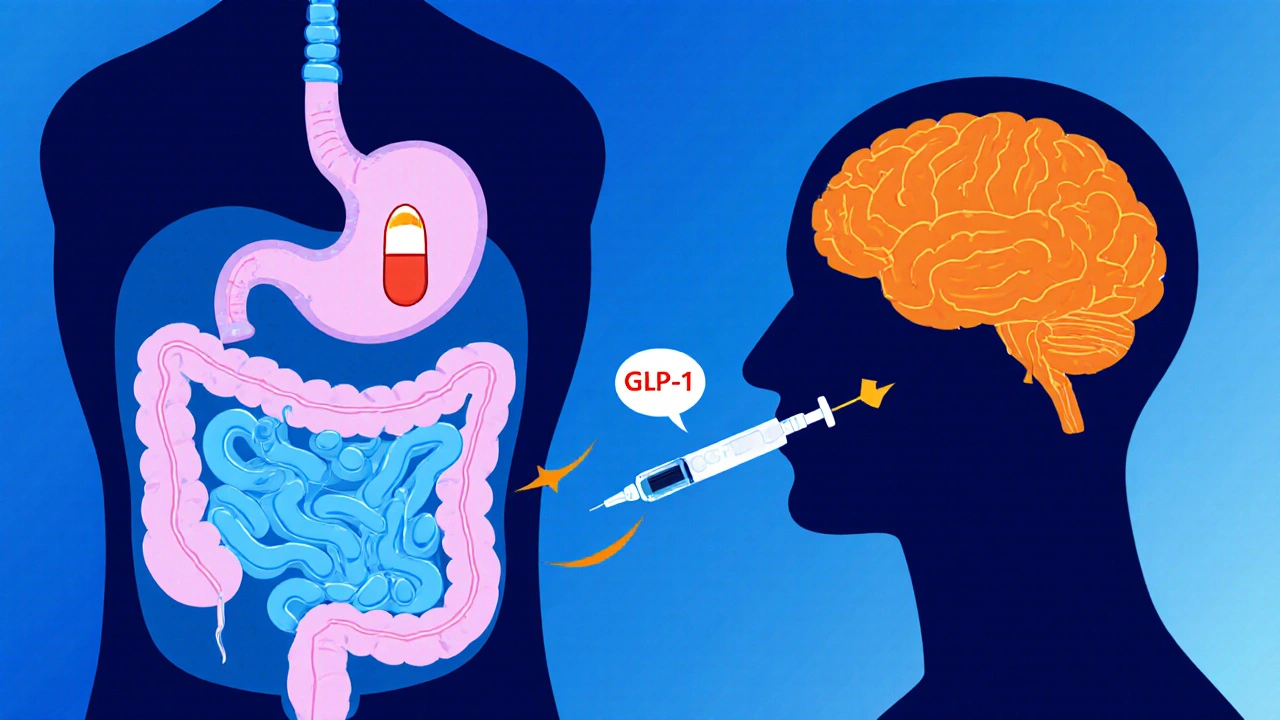Weight Loss Medication Comparison Tool
Quick Takeaways
- Orlistat blocks fat absorption and is taken with meals, but can cause oily stools.
- GLP‑1 agonists like semaglutide and liraglutide deliver the biggest average weight loss (10‑15% in a year).
- Combination pills such as phentermine/topiramate or bupropion/naltrexone add appetite suppression to the mix.
- Choose a drug that matches your health profile, lifestyle, and how quickly you want results.
- Always pair medication with a balanced diet and regular activity for sustainable outcomes.
What Is Orlistat?
Orlistat is a prescription and over‑the‑counter (OTC) lipase inhibitor approved by the U.S. Food and Drug Administration (FDA) for chronic weight management. It works locally in the gastrointestinal tract, preventing about 30% of dietary fat from being broken down and absorbed.
How Orlistat Works
The drug binds to pancreatic lipase, the enzyme that splits triglycerides into absorbable fatty acids. By inhibiting this step, the undigested fat is expelled in the stool. Because the effect is confined to the gut, systemic exposure is minimal, which limits drug‑drug interactions.

Key Benefits and Common Side Effects
Orlistat can produce a modest 3‑5% reduction in body weight after six months when combined with a reduced‑calorie diet. The advantage is its safety profile for people who cannot tolerate stimulant‑based appetite suppressants.
Typical side effects stem from the unabsorbed fat: oily spotting, loose stools, and occasional fecal urgency. Taking the medication with a low‑fat meal (under 30g) can blunt these issues. Rarely, users develop fat‑soluble vitamin deficiencies, so a multivitamin taken at a different time of day is recommended.
Top Alternatives to Orlistat
When you need stronger weight loss or a different mechanism, several FDA‑approved options exist.
Liraglutide
Liraglutide is a glucagon‑like peptide‑1 (GLP‑1) receptor agonist marketed as Saxenda for obesity. It mimics an intestinal hormone that tells the brain you’re full, reducing appetite and slowing gastric emptying. Clinical trials show an average 8‑10% body‑weight loss after a year of daily injections.
Semaglutide
Semaglutide, sold as Wegovy for weight loss, is another GLP‑1 agonist but with a once‑weekly subcutaneous dose. In the STEP trials, participants lost about 15% of their baseline weight over 68 weeks, making it the most effective medication currently available.
Phentermine/Topiramate
Phentermine/Topiramate (Qsymia) combines a sympathomimetic appetite suppressant with an antiepileptic that promotes satiety. The duo yields roughly 9‑11% weight loss after one year, but the stimulant component can raise heart rate and blood pressure, so cardiac screening is advised.
Bupropion/Naltrexone
Bupropion/Naltrexone (Contrave) merges a dopamine‑norepinephrine reuptake inhibitor with an opioid antagonist. Together they curb cravings and improve mood, delivering about 5‑7% weight loss over six months. Patients with seizure disorders or uncontrolled hypertension should avoid this combo.
Phentermine
Phentermine alone is a short‑term (up to 12 weeks) stimulant that suppresses appetite via central nervous system activation. It can produce 5‑9% weight loss quickly, but tolerance develops fast and side effects include insomnia, dry mouth, and elevated pulse.
Side‑by‑Side Comparison
| Medication | Mechanism | Typical Administration | Avg. % Body‑Weight Loss (12mo) | Common Side Effects | FDA Status |
|---|---|---|---|---|---|
| Orlistat | Lipase inhibition (fat malabsorption) | 120mg capsule, TID with meals | 3‑5% | Oily stools, flatulence, vitamin deficiency | Prescription & OTC |
| Liraglutide | GLP‑1 receptor agonist (appetite suppression) | 0.6mg daily subcutaneous | 8‑10% | Nausea, vomiting, pancreatitis risk | Prescription |
| Semaglutide | GLP‑1 receptor agonist (appetite suppression) | 2.4mg weekly subcutaneous | 14‑15% | Nausea, constipation, gallbladder disease | Prescription |
| Phentermine/Topiramate | Stimulant + GABA‑modulator (appetite & satiety) | Varies, daily oral | 9‑11% | Dry mouth, paresthesia, ↑BP | Prescription |
| Bupropion/Naltrexone | Dopamine‑NE reuptake + opioid antagonism (craving control) | 2 tablets BID | 5‑7% | Headache, nausea, insomnia | Prescription |
| Phentermine | Sympathomimetic (appetite suppression) | 15‑37.5mg daily oral | 5‑9% (short‑term) | Elevated HR, insomnia, anxiety | Prescription (short‑term only) |

How to Pick the Right Option for You
Consider these decision points before starting any medication:
- Health conditions: Diabetes, heart disease, seizure disorders, or liver/kidney impairment steer you toward or away from certain drugs.
- Desired speed of loss: GLP‑1 agonists give the quickest, biggest drop; Orlistat delivers slower, steady loss.
- Route of administration: If you dislike injections, stick to oral choices like Orlistat, Phentermine, or the combination pills.
- Cost and insurance coverage: Injectable GLP‑1 drugs often have higher out‑of‑pocket costs than generic Orlistat.
- Side‑effect tolerance: Fat‑related GI symptoms versus nausea versus stimulant‑related cardiovascular effects.
Work with a clinician who can run baseline labs (lipid panel, liver enzymes, vitamin D) and assess your cardiovascular risk before prescribing.
Practical Tips and Common Pitfalls
Regardless of the medication, the following habits boost success:
- Track calories and macronutrients for at least two weeks to understand your baseline.
- Schedule meals around the drug’s dosing window (e.g., Orlistat with each main meal).
- Take a daily multivitamin that includes vitamins A, D, E, and K if you choose a fat‑blocking agent.
- Stay hydrated; some agents (GLP‑1 agonists) can cause mild dehydration.
- Set realistic milestones-5% loss in three months is a healthy target for most drugs.
A common mistake is abandoning the medication when weight loss plateaus. Most drugs have a maintenance phase; adjusting dose or adding behavioral counseling can reignite progress.
Frequently Asked Questions
Can I use Orlistat with a high‑fat diet?
Orlistat works best when dietary fat stays below 30g per meal. A high‑fat diet overwhelms the drug’s capacity, leading to more GI side effects without extra benefit.
Do GLP‑1 drugs cause hypoglycemia?
When used for obesity in people without diabetes, GLP‑1 agonists rarely cause low blood sugar. If you’re also on insulin or sulfonylureas, your doctor will adjust doses.
How long should I stay on Orlistat?
Orlistat can be used long‑term as long as you maintain adequate vitamin levels and tolerate the GI effects. Periodic check‑ups every six months help monitor safety.
Is it safe to combine Orlistat with a GLP‑1 agonist?
There’s no strong evidence against using both, but the combined cost and pill burden are high. Most clinicians reserve combination therapy for patients who haven’t responded to a single agent.
What lab tests are needed before starting any weight‑loss medication?
Baseline fasting glucose, HbA1c, lipid panel, liver enzymes, kidney function, and a full vitamin D level are standard. For GLP‑1 drugs, a pregnancy test is required in women of child‑bearing age.
Choosing a weight‑loss medication is a personal journey. By comparing mechanisms, efficacy, side‑effect profiles, and practical considerations, you can find a therapy that fits your health goals and lifestyle.


In the grand arena of American health sovereignty, Orlistat stands as a gritty infantryman-blocking dietary fat with the ferocity of a battlefield siege. Its lipase‑inhibiting mechanism is the tactical artillery that forces the excess caloric hordes into exile. While the GLP‑1 titans roar with flashy injections, the humble pill proves that rugged, home‑grown resilience can still win the war against obesity. Side‑effects? Just the collateral of a hard‑fought campaign-oily stools are the smoke of victory. So if you crave a home‑grown, FDA‑approved bulwark, strap on Orlistat and march onward.
Looking at the data, each medication brings a unique trade‑off, and that’s totally okay 😊. If you value a once‑weekly injection and are okay with potential nausea, semaglutide offers impressive numbers. For those who prefer oral pills and want a low‑cost entry, Orlistat remains a solid choice. Consider your health profile, your budget, and your tolerance for GI quirks, then pick the tool that fits best. It's all about personal alignment, not a one‑size‑fits‑all. 👍
It would be a moral failing to chase quick fixes without confronting the deeper societal rot that fuels obesity. While pharma peddles potent GLP‑1 concoctions, we must ask whether we’re medicating a symptom of a culture that glorifies over‑consumption. Orlistat, with its modest efficacy, forces users to reckon with dietary habits rather than blithely injecting away the problem. The ethical path is to combine disciplined nutrition with any pharmacologic aid, not to abdicate responsibility to a pill. Thus, the true heroics lie in lifestyle overhaul, not in surrendering autonomy to a capsule.
Ah, the scintillating world of weight‑loss pharmacology-truly the pinnacle of human achievement. One might as well compare the nuanced flavor profile of Orlistat to the haute‑cuisine of semaglutide, if one enjoys a side of oily stools for dessert. The table of data is as crisp as a well‑pressed suit, and the side‑effects list reads like a literary footnote. For the discerning elite who prefers subtle inconvenience over dramatic results, Orlistat is practically poetry. Or perhaps it’s just a reminder that not all that glitters is a revolutionary injection.
Weight loss is a journey, not a destination. Orlistat works by blocking fat, so the body learns to rely on less excess. This simple principle mirrors the larger truth: when we remove shortcuts, we grow stronger. Some may find the oily stools unpleasant, but they signal that the drug is doing its job. In the end, consistency beats flash.
Haha, love the satire! While Orlistat may feel like culinary roulette, at least it doesn’t require a monthly trip to a clinic for a needle‑fancy. If you can handle a few extra bathroom trips, you get the cheap, OTC edge that many high‑priced injectables lack. So for the pragmatic, it’s a win‑win-budget‑friendly and self‑managed.
Sure, because nothing says “I’m committed” like juggling multivitamins and timing meals around a pill. The real challenge isn’t picking the smartest drug; it’s remembering to actually eat less while your friends binge on pizza. So kudos to anyone who can keep the fridge stocked with greens and still resist that extra slice-now that’s the true medal of honor.
Indeed-consistency is the cornerstone of transformation; however, consider that habit formation is a neuro‑chemical cascade, and every small victory reinforces the prefrontal pathways! By pairing Orlistat with mindful eating, you’re essentially rewiring your reward circuitry-yes, it’s science, and yes, it’s doable!!! Keep tracking those macros, stay patient, and the results will follow, one disciplined day at a time.
orlistat r cool but the stool stuff is nasty
🚀 Ready to blast off on your health journey? Whether you choose a weekly injection or an OTC capsule, the key is commitment and consistency. Remember, every small step-like swapping soda for water-adds up to massive gains. Stay positive, stay active, and let your goals fuel the momentum! 🌟💪